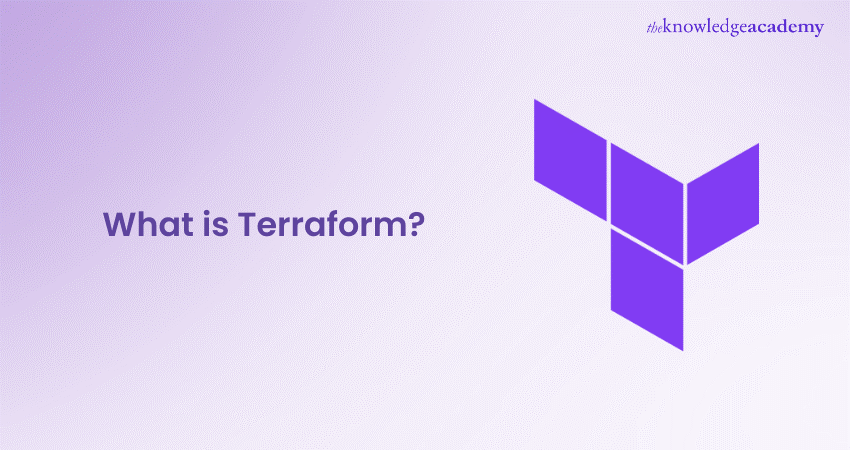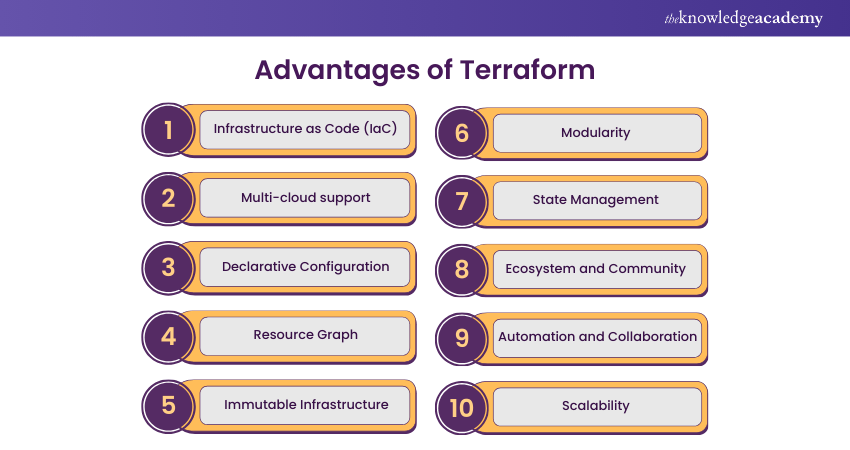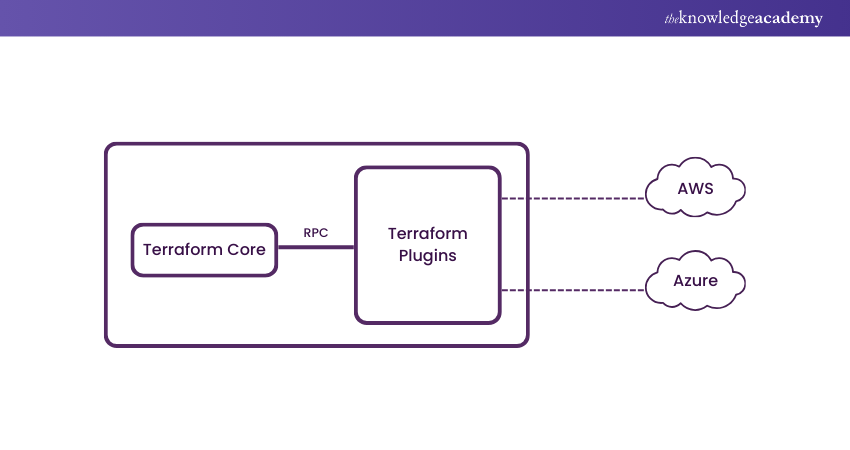We may not have the course you’re looking for. If you enquire or give us a call on 01344203999 and speak to our training experts, we may still be able to help with your training requirements.
We ensure quality, budget-alignment, and timely delivery by our expert instructors.

Imagine being able to build and manage your entire cloud infrastructure with just a few lines of code. That’s exactly what Terraform offers! Terraform is a powerful open-source tool that simplifies the process of creating, managing, and scaling infrastructure. In this blog, we will discuss What is Terraform, how it works, and why it’s a game-changer for Cloud Computing. Whether you’re a beginner or an experienced professional, this blog will help you understand how Terraform simplifies IT operations and makes your workflows faster and more efficient.
Table of Contents
1) What is Terraform?
2) What is Terraform Used for?
3) Advantages of Terraform
4) How Does Terraform Work?
5) Terraform Workflow
6) Core Elements of Terraform
7) Terraform Example Use Cases
8) What is Terraform vs Ansible?
9) Conclusion
What is Terraform?
Terraform is an open-source Infrastructure as Code (IaC) tool crafted by HashiCorp, designed to simplify and automate cloud infrastructure provisioning. With a declarative configuration language, users define desired infrastructure states, and Terraform orchestrates resource creation, modification, and deletion. It supports multiple cloud providers and services, enabling users to manage complex infrastructure deployments efficiently. Terraform's versatility, ease of use, and ability to ensure consistent and reproducible infrastructure make it a widely adopted solution for automating and streamlining the process of building and managing scalable environments in the cloud, as detailed in the Terraform Cheat Sheet Guide. For those preparing for a Terraform role, exploring Terraform Interview Questions and Answers can provide valuable insights into the core concepts and best practices.
What is Terraform Used for?
Terraform is primarily used for public cloud provisioning with major providers such as AWS and Azure. By providing Infrastructure as Code (IaC) for these services, Terraform simplifies and automates cloud resource management using a provider plugin that integrates with existing Application Programming Interfaces (APIs) and languages like Azure Bicep.
Another key use of Terraform is facilitating multi-cloud deployments. Unlike some IaC competitors, Terraform operates across all cloud providers simultaneously, allowing engineers to deploy resources to multiple clouds using the same syntax and eliminating the need to learn different tools and technologies.
Additionally, Terraform is commonly used for deploying and managing resources with custom Cloud providers. Providers in Terraform wrap existing APIs and convert them to Terraform's declarative syntax, making it versatile for both major and custom cloud services, as well as internal tools and APIs.
Advantages of Terraform
Let’s discuss some advantages of Terraform:

a) Infrastructure as Code (IaC): Terraform allows defining and managing infrastructure using code, enhancing version control, and facilitating collaboration among teams.
b) Multi-cloud Support: It is cloud-agnostic, supporting various providers like AWS, Azure, Google Cloud, and more, enabling you to manage diverse environments consistently.
c) Declarative Configuration: Its declarative syntax lets users describe the desired infrastructure state, and Terraform handles the execution details, ensuring the system converges to the specified state.
d) Resource Graph: It builds a graph of resource dependencies, optimising deployment by executing tasks concurrently when feasible and enhancing efficiency.
e) Immutable Infrastructure: It promotes the creation of immutable infrastructure, allowing easy replication and consistent environments, reducing configuration drift, and enhancing reliability.
f) Modularity: The modular design enables the creation of reusable modules, promoting best practices, consistency, and efficiency across projects.
g) State Management: It maintains a state file to track the current state of infrastructure, facilitating updates and modifications and avoiding unnecessary resource recreation.
h) Ecosystem and Community: A vibrant ecosystem and active community contribute to a rich library of modules and extensive documentation, providing solutions for various use cases and promoting knowledge sharing.
i) Automation and Collaboration: It automates the provisioning process, enhancing efficiency, and supporting collaborative efforts through shared code repositories and collaborative workflows.
j) Scalability: It scales effortlessly, accommodating projects of any size, from small deployments to large, complex infrastructures, ensuring adaptability to diverse organisational needs.
How Does Terraform Work?
Terraform works by combining two main parts: Terraform Core and Plugins.

Terraform Core
This is the main part of the tool that handles managing your infrastructure. It is an open-source program you can run from the command line. Core compares the current setup of your infrastructure with the setup you want (as defined in your configuration). Based on this, it creates a plan to add, change, or remove resources. Once you approve the plan, Terraform Core makes the changes, like setting up or removing resources.
Terraform Plugins
It acts as a connector between Core and the cloud services or software you use. Examples of plugins include Providers (for cloud platforms like AWS or Azure) and Provisioners (for configuring resources). Core communicates with these plugins using a process called Remote Procedure Call (RPC). Together, Core and Plugins ensure Terraform can build and manage your infrastructure.
Learn cloud infrastructure with our Cloud Computing Courses- Join today!
Terraform Workflow
This is how the workflow of Terraform works:
Step 1. Write
In the initial phase, you can create Terraform configuration files using HashiCorp Configuration Language (HCL). These files define the desired infrastructure state, specifying resources, their configurations, and dependencies. You can articulate the infrastructure as code, facilitating version control and collaborative development.
Step 2. Review
After writing the configuration files, you can generate an execution plan using the ‘terraform plan’ command. This step allows you to review the proposed changes and understand the modifications it intends to make to the infrastructure. It provides a detailed summary of resource creation, modification, or deletion, enabling users to verify the plan's alignment with their expectations.
Step 3. Apply
Once satisfied with the execution plan, you can apply it using the ‘terraform apply’ command. It interacts with the relevant Cloud provider APIs to implement the planned changes, creating or modifying resources accordingly. The apply step prompts you to confirm the changes before proceeding, ensuring a controlled and deliberate deployment.
Core Elements of Terraform
In this section, we will explore the core elements of Terraform:
Terraform CLI
The Terraform Command Line Interface (CLI) is the primary tool for interacting with Terraform. It allows users to execute commands to manage infrastructure, such as init to set up a working directory, plan to create an execution plan, apply to implement changes, and destroy to remove resources.
The CLI is essential for managing the entire lifecycle of infrastructure as code, providing a powerful and flexible way to automate and control deployments.
Terraform Language
Terraform Language, also known as HashiCorp Configuration Language (HCL), is a declarative language used to define infrastructure. It allows users to specify resources, configurations, and dependencies in human-readable syntax. HCL enables the creation of reusable and shareable configurations, supporting variables, expressions, and modules to streamline complex setups.
The language's simplicity and flexibility make it accessible for defining infrastructure as code, ensuring consistent and repeatable deployments across different environments.
Terraform Providers
Terraform Providers are plugins that enable Terraform to interact with various Cloud services, on-premises solutions, and third-party APIs. Each provider defines resources and data sources for specific services, such as AWS, Azure, or Google Cloud. Providers abstract the underlying API interactions, allowing users to define infrastructure in a consistent, provider-agnostic manner.
By supporting a wide range of providers, Terraform can manage diverse environments and integrate with numerous services, enhancing its versatility and applicability.
Terraform Modules
Terraform Modules are reusable packages of Terraform configurations that encapsulate groups of resources. They allow users to organise and share infrastructure code, promoting best practices and consistency across projects. Modules can be sourced from local directories, version control systems, or the Terraform Registry.
By using modules, teams can simplify complex configurations, reduce duplication, and enhance collaboration, making it easier to manage and maintain large-scale infrastructure deployments.
Terraform State
Terraform State is a critical component that tracks the current state of infrastructure managed by Terraform. It stores metadata and resource attributes, enabling Terraform to determine the changes required to reach the desired state. State files are used to plan and apply updates efficiently, ensuring consistency and accuracy.
Terraform supports remote state storage for collaboration and locking mechanisms to prevent concurrent modifications. Proper state management is vital for reliable and predictable infrastructure provisioning.
Become an expert in Linux OpenStack – register now with our Linux OpenStack Administration Training!
Terraform Example Use Cases
Here are some examples of how Terraform can be used effectively:
1) Creating Cloud Resources
a) You can use Terraform to set up things like servers, storage, and databases in cloud platforms such as AWS, Azure, or Google Cloud.
b) Example: Automatically create a virtual machine, connect it to storage, and set up a database.
2) Multi-cloud Management
a) Terraform works with multiple cloud providers at the same time.
b) Example: Use AWS for storage and Google Cloud for computing, all managed with one Terraform script.
3) Automating Infrastructure
a) Terraform helps you avoid doing repetitive tasks manually by writing code to handle it.
b) Example: Instead of clicking buttons to set up 10 servers, you write a script to do it instantly.
4) Version Control for Infrastructure
a) Just like you track changes in code, you can track infrastructure changes using Terraform.
b) Example: If a mistake happens, you can go back to a previous version of your setup.
5) Scaling Resources
a) With Terraform, you can easily add or remove resources when needed.
b) Example: Automatically add more servers if your website traffic increases.
6) Testing Infrastructure
a) You can create a temporary environment to test your setup before using it for real.
b) Example: Create a duplicate of your live environment to test changes without risking issues.
7) Infrastructure as Code (IaC)
a) Terraform allows you to manage your setup using code instead of doing things manually.
b) Example: Share the code with your team to standardise setups across projects.
8) Disaster Recovery
a) Terraform makes it easy to recreate infrastructure quickly after a failure.
b) Example: If your server crashes, you can use Terraform scripts to restore it in minutes.
9) Collaborating with Teams
a) Teams can work together on infrastructure by using the same Terraform files.
b) Example: A developer can create a script, and the IT team can use it to set up the system.
10) Cost Management
a) Terraform helps track what resources you’ve created and ensures you’re not paying for things you don’t need.
b) Example: Clean up unused resources to reduce your cloud bill.
What is Terraform vs Ansible?
Terraform and Ansible are tools that help manage IT infrastructure, but they are used for different purposes. Terraform is mainly used to set up and manage infrastructure, like creating servers, networks, and databases. It works by defining everything as code and is great for building infrastructure from scratch or making big changes.
Ansible, on the other hand, is used to configure and manage existing infrastructure. It helps with tasks like installing software, updating servers, or managing settings. While Terraform focuses on creating resources, Ansible focuses on maintaining and configuring them. Many teams use both tools together to handle their infrastructure needs, especially when evaluating Ansible vs Terraform for specific use cases. Furthermore, Ansible Interview Questions can help deepen your understanding of configuration management and deployment strategies.
Conclusion
Get ready for your next interview! Explore detailed Terraform Interview Question and Answers to boost your chances of landing the job you want.
We hope you have understood What is Terraform and how it helps manage cloud infrastructure easily. Terraform makes it simple to create, update, and scale resources while working with multiple cloud providers. Understanding the difference between Terraform and Kubernetes can further enhance your approach to cloud management. It’s a great tool for saving time and ensuring everything runs smoothly. Start learning Terraform today to make your IT processes faster and more efficient!
Do you want to gain in-depth knowledge and acquire the skills for easy troubleshooting? Register now for our Microservices Architecture Training !
Frequently Asked Questions
Explain the Differences Between Terraform vs Kubernetes

Terraform is an Infrastructure as Code (IaC) tool for provisioning and managing cloud resources, while Kubernetes is an orchestration platform for automating deployment, scaling, and management of containerised applications. Terraform manages infrastructure, whereas Kubernetes manages application workloads.
What are Terraform Commands?

Terraform commands are used to manage infrastructure. Examples include ‘init’ to set up a working directory, ‘plan’ to preview changes, ‘apply’ to make updates, and ‘destroy’ to remove resources.
What are the Other Resources and Offers provided by The Knowledge Academy?

The Knowledge Academy takes global learning to new heights, offering over 3,000 online courses across 490+ locations in 190+ countries. This expansive reach ensures accessibility and convenience for learners worldwide.
Alongside our diverse Online Course Catalogue, encompassing 19 major categories, we go the extra mile by providing a plethora of free educational Online Resources like News updates, Blogs, videos, webinars, and interview questions. Tailoring learning experiences further, professionals can maximise value with customisable Course Bundles of TKA.
What is The Knowledge Pass, and How Does it Work?

The Knowledge Academy’s Knowledge Pass, a prepaid voucher, adds another layer of flexibility, allowing course bookings over a 12-month period. Join us on a journey where education knows no bounds.
What are the Related Courses and Blogs Provided by The Knowledge Academy?

The Knowledge Academy offers various Cloud Computing Courses, including Terraform Training, Linux OpenStack Administration Training, and Microservices Architecture Training. These courses cater to different skill levels, providing comprehensive insights into Cloud Computing.
Our Cloud Computing Blogs cover a range of topics related to Terraform, offering valuable resources, best practices, and industry insights. Whether you are a beginner or looking to advance your Cloud Computing skills, The Knowledge Academy's diverse courses and informative blogs have you covered.






 Top Rated Course
Top Rated Course




 If you wish to make any changes to your course, please
If you wish to make any changes to your course, please


